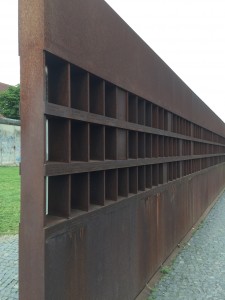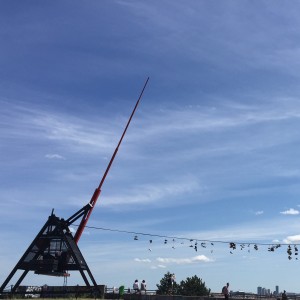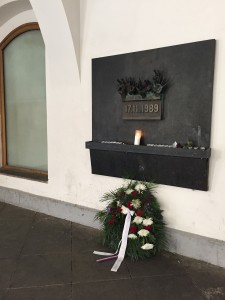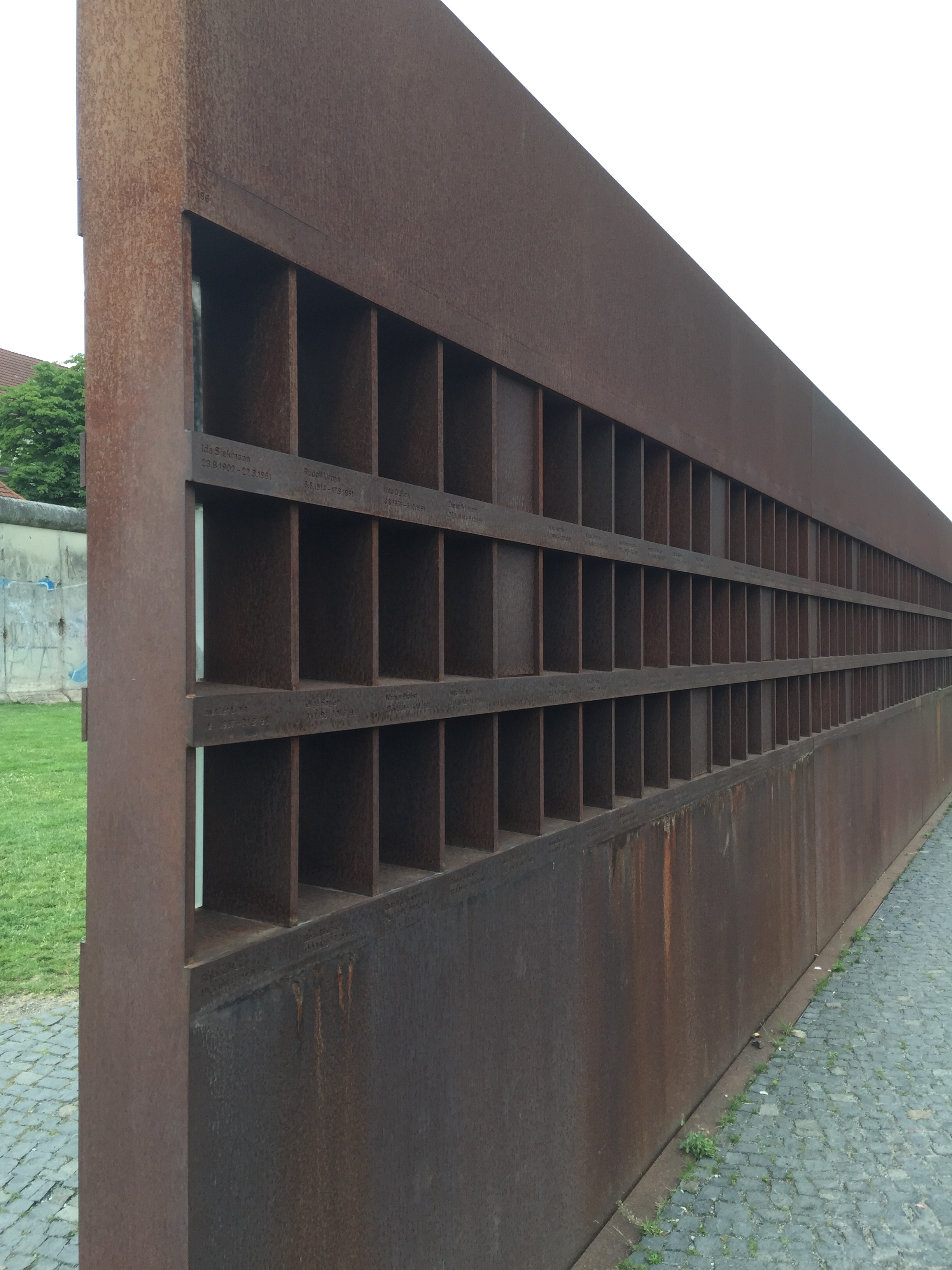Hi everyone,
I can’t believe that my research trip is over! I’m still processing everything I read and saw while in Europe, but am excited to work through the material and develop the film I shot.
After Poland, I spent about two weeks in Berlin. Though I gathered an extensive amount of information, I also feel like I lost some of my research direction. I had originally intended to focus on the Berlin Wall, as well as three Soviet war memorials, however I visited many other sites that will probably be more supplementary in use.
I’ve been interested in the Berlin Wall for some time, having previously worked on a paper about pieces of the Berlin Wall in New York. Though the Wall may be physically absent from most of Berlin, the variety of sites and forms of remembrance — from markings on the ground and informational posts around the city, to more exhibitions and memorials, makes it feel present. I walked just a fraction of the Berlin Wall Trail, and I kept finding other forms of remembrance, which was both exciting and overwhelming!

I also began to think about the commercialization of history. Gift shop after gift shop sold “pieces” of the Wall. Regardless of the authenticity, the idea that an international symbol of ideology and of a historical moment, can be taken home by any visitor in a pocket-sized piece, is quite unusual.
My last stop was Prague, which seems fitting given my project inspiration came from a class I took while studying abroad there.
I focused on the Metronome in Letna Park. An enormous statue of Stalin once stood on the same base where the Metronome now does. The statue was unveiled in 1955, after Stalin actually died, and was blown up in 1962 — several years after the cult of Stalin was denounced.

Today, the site is used by skateboarders, swing-dancers and residents hanging out. A bar, called Stalin, recently opened for the summer and is using part of the base as storage space. I was able to walk around inside, which was incredible!
I also spent time working in the National Archives. This was an amazing opportunity, but my lack of language skills was frustrating (though thanks to Google Translate, I was able to get a sense of what I was looking at).
I also discovered several relevant memorials, which though I had passed several of them before, I didn’t truly see them until I went looking for them. The spaces they occupy are in busy areas of Prague, which makes for an unusual dynamic: many people pass them each day, but they also blend into the landscape.

Each place that I visited during my research had a unique landscape of memory in relation to Communism, and often one still shifting. The individual context of each place played a large role in questions of state-participation in formal memory, as well as towards questions of preservation and dominant narratives.
I am grateful for all of the help and support from faculty at NYU Berlin and NYU Prague, who enriched my project and agreed to be interviewed. I would also like to thank my friends and family for their support!
I’m not really sure how all the pieces of my research will ultimately fit together, as there are a few different directions I could go in. I’m hoping to use this research and my photographs for a potential senior project, and am looking forward to its evolution.

Hi Emily,
I’m glad to hear that your time in Berlin was chock full of discoveries. I am very interested in the idea of ‘found’ objects, how one comes to know an object through one’s unveiling and unearthing of it from the depths of memory and time. What Maya brought up about haunted sites has also been pertinent to my research: how a historical site can rebuild and recover from years of systemic trauma and recycled representations. As you have noted, buildings and monuments can change meaning over many years. Do you think that meanings are maintained by the buildings themselves, or lack thereof, or the people who build and tear them down? Are buildings powerful because we build them, or because they may last longer than us?
-Brenda
Hi Emily!
This was a fascinating post, and sounds like a really wonderful trip. I spent the spring semester of 2014 in Berlin, so I immediately connected to your research. I understand the difficulty of feeling like the research and thesis could go in a lot of different directions. I myself am having that same problem. There were a couple parts that I am curious to hear more about:
You mentioned the commercialization of history. That’s such a fascinating concept, particularly in Berlin with the “pieces” of the wall being sold. I think that could be a one jumping off point for examining the more potentially informal historical narratives of memorials. How does ideology translate into these physical souvenirs? It’s also interesting that they are sold in gift shops, marketed toward tourists. How does the concept of ownership play into that—owning a small part of something much larger both physically and ideologically? I don’t know if this is making sense, but I am really interested in the idea.
Secondly, I am really interested in the Metronome–an object that signifies the passage of time. In general, I am interested in the idea of destroying buildings/statues/public sites and rebuilding something new there—in this case the decision to put something at the spot where Stalin once stood. The fact that there is now a bar called the Stalin seems to show the way the past still haunts the site, but the name has been utterly transformed. How do these sites reflect aspects Prague today and simultaneously echo a difficult past?